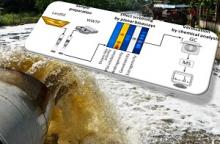- About us
- Research
- Students & Teaching
- Seminars & Events
- Directories
- Booking Rooms & Equipment
- עברית
Home » Monitoring bioactive components in wastewater and landfill leachates
Identification of environmental pollutants by chemical analysis, which can be highly accurate and extremely sensitive, may nevertheless encounter significant difficulties when the sampled environment is highly complex (e.g. wastewater), and when no specific analytes are targeted. One possible solution is the application of bioassays, which examine the biological activity of the sample, rather than its precise chemical composition.
Prof. Belkin's group, in collaboration with researchers from the German Federal Institute of Hydrology headed by Dr. Sebastian Buchinger, have improved upon a methodology that combines the two analytical approaches. First, the sample is chromatographically separated on a silica-coated glass plate (thin layer chromatography, TLC), and then the plate is sprayed with a culture of genetically engineered microorganisms, “tailored” to emit an optical signal in the presence of their target compounds. A few hours later, only those sample components which possess the targeted bioacativity (e.g. mutagenicity) will reveal themselves by a bright spot forming above them. This then allows to focus the analytical efforts on a few toxic compounds only, and not on the entire sample.
Guided by Prof. Shimshon Belkin and Dr. Liat Moscovici, the students Nidaa Abu Rmaileh, Hadas Atias and Dror Shakibai have developed a series of such cellular sensors, based on bacterial or yeast strains. Genetically engineered to detect two classes of environmental pollutants, endocrine disrupting compounds and DNA-damaging agents, these sensors have been used to demonstrate the existence of chemicals from both groups in wastewaters. The results of these studies have been reported in a series of scientific articles, the most recent of which has been published in the May 2021 issue of Ecotoxicology and Environmental Safety.
